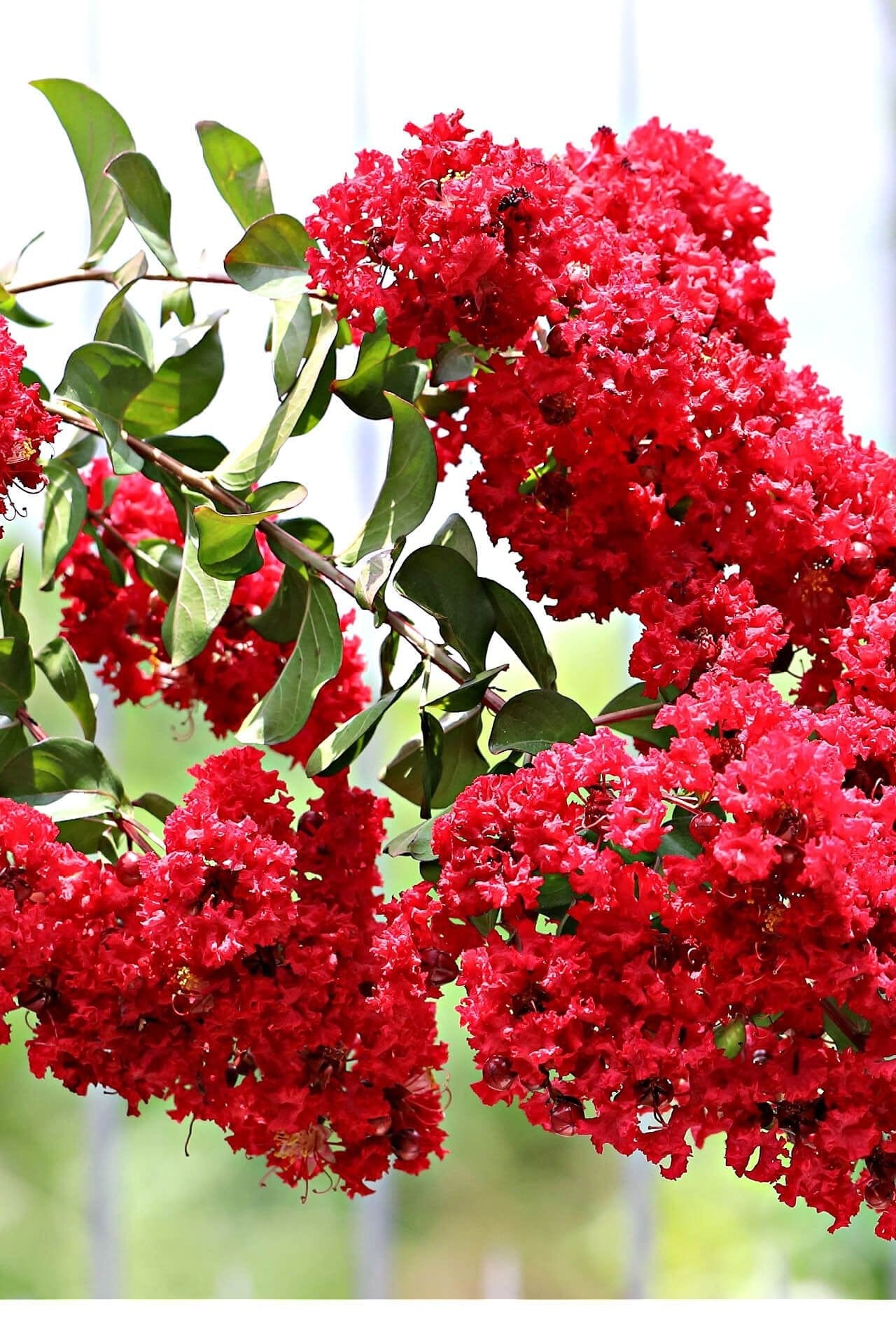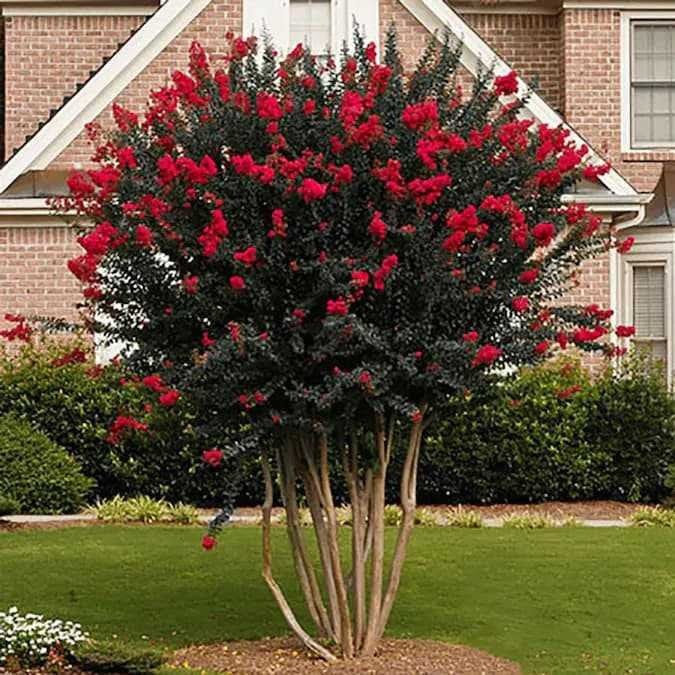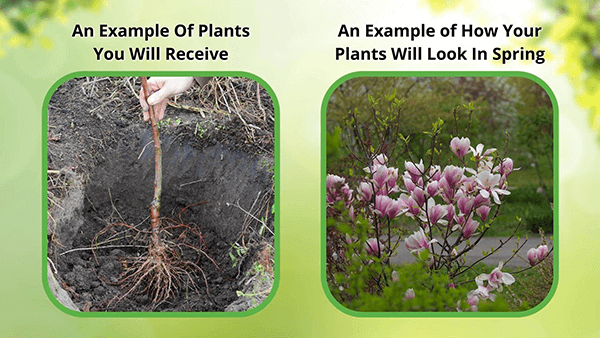Red Crepe Myrtle
Red Crepe Myrtle
Couldn't load pickup availability
We do not ship this plant to the following states:
OR. AZ.Ships November 2025
Under 25 Feet
Full Sun
6-9
Flowering
Bare-root
OR. AZ.
Lagerstroemia indica 'Red Rocket' - Red Crepe Myrtle
The Red Crepe Myrtle is a stunning deciduous tree highly valued for its colorful and showy flowers. This tree is widely used in landscapes for its vibrant red blossoms in summer and Fall (End of October). This product page will explore the shrub's unique features and suitability for landscape designs.
Red Crepe Myrtle's Appearance
They grow to 20-30 feet tall and wide and have a rounded, spreading habit. The tree has smooth, gray-brown bark that peels in thin sheets, revealing a soft, cream-colored layer beneath. The leaves are dark green, and in the Fall (End of October), they turn shades of orange, red, and yellow, adding a lovely autumnal touch to your landscape. However, the blossoms are the tree's most remarkable feature. They produce abundant clusters of deep red flowers covering the tree branches from mid-summer to early Fall (End of October), creating an eye-catching display.
Maintenance
They are easy to grow and maintain, making them an in-demand choice for homeowners and landscapers. They prefer well-drained soil and total sun exposure, though they can tolerate some shade. Once established, the tree is relatively drought-tolerant and does not require frequent watering. It is also resistant to pests and diseases, making it a low-maintenance addition to your landscape.
Landscaping With These Versatile Trees
They are versatile trees in various landscape designs. Its vibrant flowers make it an excellent focal point or specimen tree in a front yard, while its spreading habit makes it ideal for shade and privacy screens. The tree's stunning autumn foliage adds dimension to the landscape design, making it a popular choice for seasonal interest. They are also an excellent tree for attracting birds, bees, and other pollinators to your yard.
Benefits
Red Crepe Myrtle is an exceptional tree that brings beauty, interest, and wildlife to your landscape. Its stunning red blossoms, low maintenance requirements, and adaptability make it an excellent addition to any home or commercial landscape design. Contact us today to learn more about our selection and how we can help you incorporate it into your landscape.
It is a magical canopy. Your house becomes increasingly your home as you add your personal touches. As life changes, those personal touches change. A beautiful yard is one of the greatest gifts you can give yourself and your family. As you come home, seeing the landscaping you designed and that you and your family work on can make the day's stresses melt away in an instant. Adding these stunning, brilliant trees to complement the greenery will make your yard and garden pop from the end of the street.
That bright canopy high above your lawn adds a dimension to your yard and gives it surprising depth. With this tree growing in your yard, you'll feel like you're in the magical land of your creation. They grow up to 25 feet and offer a 20-foot canopy of crimson that blankets the sky over your yard. They're drought tolerant and mildew, pest, and disease resistant.
Their beauty comes alive in the Spring and graces your yard through summer. They grow well in zones 7 through 9, enjoy full sun, are hardy down to 10° F, and reach their full height in about ten years. It's a treat to step outside in the evening to water and tend your plants. After a day at the grind, spending time in a beautiful place of your creation is about as good as it gets. Give yourself the joy of a bright, vibrant yard that excites you and warms your heart every time you see it. Enjoy the pride of ownership and creation that a well-landscaped yard can foster. Make it powerfully unique with this tree. Give yourself the unequaled splendor of the trees. All our trees are shipped to the consumer in bare root form, helping to ensure that they arrive in excellent condition.
They are trendy trees down south, and you will be happy to sit with one and let it cover a part of your yard. It has that nice color you hoped for, allowing you to add red before the fall. The beautiful thing about this tree is that you can use the myrtle to add color if you want something other than flowers or shrubs on your lawn.
You can use this myrtle in the middle of the yard if that is what you want, or you can set up things around it. The bushes you use seem too bland, and you can get that color from the myrtle so much easier than if you were going to avoid a fence.
You can create an excellent barrier around your property, and you will get interested in trimming these trees and ensuring they look much better. You also have to be sure that you have chosen the trees. They glisten this nice color, making it much easier for you to have myrtle because they stand up to the weather.
They produce stunning bright flowers in the summer and are a beautiful addition to any landscape. They are a low-maintenance plant nicknamed the lilac of the south. Particular hybridization has brought some of the reddest of the red blossoms in the past few years. They require full sun and are relatively drought-tolerant.
It grows 20 feet high and can grow as much as five feet annually. Different varieties are needed for hardiness zones, but they can generally be found in U.S. Hardiness Zones 6-10.
Go with red to ensure you have made the right choices for your lawn. They seem lovely purple and red; sometimes, when you let them mature, they turn slightly brown.
This Is How Your Plants Will Look upon Delivery
Bloom/Foliage Color
Red
Shipping date depends on the date displayed and chosen when you order from the product's page.
We do not offer warranties on products after 5 days past receiving your plants.




